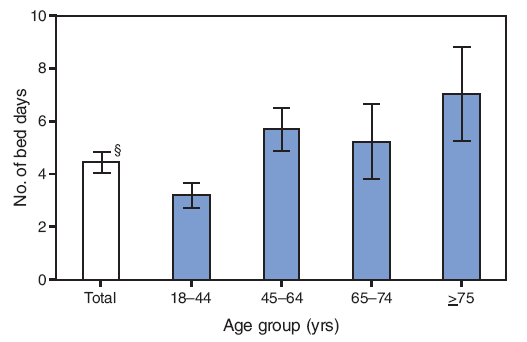Persons using assistive technology might not be able to fully access information in this file. For assistance, please send e-mail to: mmwrq@cdc.gov. Type 508 Accommodation and the title of the report in the subject line of e-mail.
QuickStats: Average Number of Illness or Injury Bed Days* During the Preceding 12 Months Among Adults Aged ≥18 Years, by Age Group --- National Health Interview Survey, United States, 2007†

* Respondents were asked, "During the past 12 months . . . about how many days did illness or injury keep you in bed more than half of the day (include days while an overnight patient in a hospital)?"
† Estimates are based on household interviews of a sample of the civilian, noninstitutionalized U.S. population and are derived from the National Health Interview Survey sample adult component.
§ 95% confidence interval.
In 2007, U.S. adults spent an average of 4.5 days in bed during the 12 months preceding the interview because of illness or injury. On average, adults aged 18--44 years had fewer bed days (3.2) than adults aged 45--64 years (5.7), 65--74 years (5.2), and ≥75 years (7.1).
SOURCE: Pleis JR, Lucas JW. Summary health statistics for U.S. adults: National Health Interview Survey, 2007. Vital Health Stat 2009;10(240). Available at http://www.cdc.gov/nchs/data/series/sr_10/sr10_240.pdf.
Alternative Text: The figure above shows National Health Interview Survey results for the average number of illness or injury bed days, during the preceding 12 months among adults aged ≥18 years, by age group in the United States in 2007.


